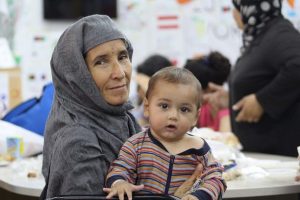Sarah Brady | June 5, 2017
“Our responses to refugees must be grounded in our shared values of responsibility sharing,non-discrimination and human rights.”
—Ban Ki-moon, United Nations Secretary-General from 2007 to 2016
June 20 is recognized internationally as World Refugee Day, a day of awareness of and for refugees across the globe. World Refugee Day was put into practice in 2001 by the United Nations General Assembly on the 50th anniversary of the 1951 Refugee Convention (a treaty that established the rights of refugees and the responsibilities of nations that grant asylum).
Since then, the way we define refugees—and the political and social climate surrounding refugees—has changed, as has the number of refugees, which now tops 21 million.
Even though nearly 34,000 people per day are forced to flee their homes because of persecution and violence, only a fraction of those people are assigned refugee status.
The UN Refugee Agency places “persons of concern” in one of five categories:
- Refugees—people forced to leave their country because of persecution or violence and who are unable to return home
- People in refugee-like situations—people who face situations similar to those of refugees, but who have not been recognized as refugees
- People with pending asylum cases—people who have fled their country and applied for asylum/sanctuary in another country
- People who are stateless—people not recognized as a citizen of any country, for legal, technical or head of state decisions
- Internally-displaced people—people who have fled their home due to persecution or violence, but remain within the borders of their country
Photo credit: Trocaire via Visualhunt / CC BY
By the numbers, worldwide (in 2015):
- 3 million forcibly-displaced people
- 3 million refugees
- 10 million stateless
For 2016’s World Refugee Day, the UN Refugee Agency launched its #WithRefugees petition, which asks governments to ensure that every refugee child gets an education; that every refugee family has a safe place to live; and that every refugee can work or make a positive impact in their community. The petition continues this year. You can sign the petition here.
If you’re interested in doing more, Refugee Council USA has put together a toolkit called Demonstrating Welcome for Refugees that includes sections on how to advocate for refugees, teambuilding in your community and sample letters to political figures. They also have a flyer about refugee resettlement in North Carolina that includes services available to refugees and organizations that help with refugee resettlement. (The largest refugee populations in North Carolina are from Burma, the Democratic Republic of Congo, Iraq, Bhutan and Somalia.)
If you plan to teach about refugees, the UN Refugee Agency has a page with resources (quizzes, games, films and more) related to refugees available here, and a toolkit here. Amnesty International has a page (from 2015) with educational resources to help teach the refugee crisis here. The Choices Program has a page dedicated to teaching the refugee crisis (complete with handouts, videos and a slideshow) here.
Join us in October! REFUGEE, a photographic exhibit from The Annenberg Space for Photography, will be at the William and Ida Friday Center from September 25 to November 3, 2017. See this exhibit and learn more about refugees when you attend World View’s fall K-12 symposium, Human Rights and Social Justice, at the Friday Conference Center in Chapel Hill on October 26–27, 2017.

